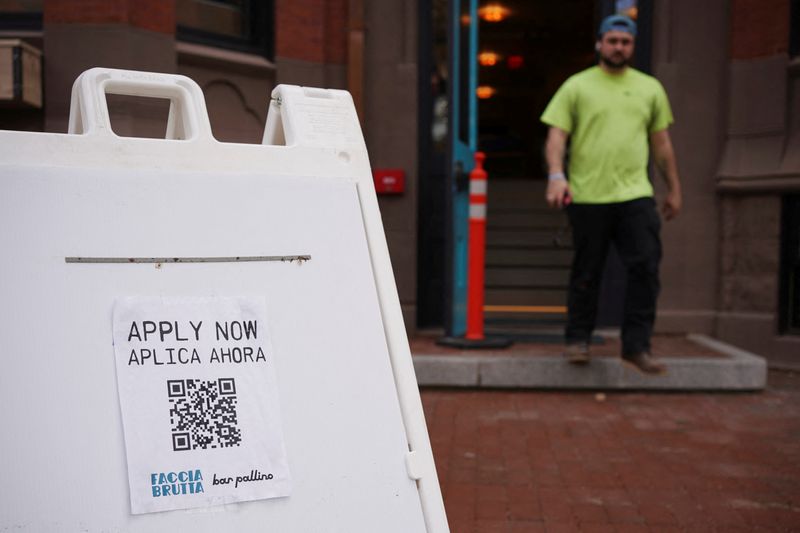By Lucia Mutikani
WASHINGTON (Reuters) - The number of Americans filing new claims for unemployment benefits unexpectedly rose last week, touching the highest level in three months, but there is no material shift in labor market conditions amid strong demand for workers.
The report from the Labor Department on Thursday also showed that the number of people on state unemployment rolls was the smallest in more than 52 years at the end of April. Companies, scrambling to fill record job openings, are boosting wages, contributing to keeping inflation elevated.
"There is no change in the underlying message of a very tight labor market and employers unwilling to lay off existing workers in the face of extreme labor scarcity," said Conrad DeQuadros, senior economic advisor at Brean Capital in New York.
Initial claims for state unemployment benefits increased 1,000 to a seasonally adjusted 203,000 for the week ended May 7, the highest level since mid-February. Data for the prior week was revised to show 2,000 more applications received than previously estimated. Economists polled by Reuters had forecast 195,000 applications for the latest week.
Claims have been largely treading water since hitting more than a 53-year low of 166,000 in March. Economists blamed the second straight weekly increase on residual volatility in the data around moving holidays like Easter, Passover and school spring breaks. Big rises in filings in California, Virginia and Illinois offset a decline of 9,811 in New York.
There were a record 11.5 million job openings on the last day of March, and nonfarm payrolls rose by 428,000 in April, the 12th straight month of employment gains in excess of 400,000. Claims have dropped from an all-time high of 6.137 million in early April 2020.
The number of people receiving benefits after an initial week of aid dropped 44,000 to 1.343 million during the week ending April 30. That was the lowest level for the so-called continuing claims since January 1970.
Stocks on Wall Street were trading mixed while the dollar rose against a basket of currencies. U.S. Treasury prices climbed.
LONG ROAD TO LOW INFLATION
The Federal Reserve last week raised its policy interest rate by half a percentage point, the biggest hike in 22 years, and said it would begin trimming its bond holdings next month.
The U.S. central bank, which started raising rates in March, hopes to bring the demand and supply of labor back in alignment, and cool wages and inflation, while avoiding high unemployment as well as an abrupt economic slowdown or recession.
While inflation remains above the Fed's 2% target, there are encouraging signs it has probably peaked, at least when measured on an annual basis. Last year's high inflation readings are dropping out of the calculation of annual inflation rates.
In another report on Thursday, the Labor Department said the producer price index for final demand rose 0.5% in April as gains in energy products slowed. That marked a sharp deceleration from March, when the PPI surged 1.6%. April's increase was in line with economists' expectations.
Energy prices rose 1.7% after shooting up 6.4% in March. Food prices climbed 1.5%. As a result, goods prices advanced 1.3% after jumping 2.4% in March. The cost of services was unchanged after vaulting 1.2% in March. But energy prices have since accelerated while demand is reverting back to services from goods, which suggests the monthly PPI will pick up in May.
In the 12 months through April, the PPI increased 11.0% after accelerating 11.5% in March.
"While inflation is still looking strong, there are some signs that we may have moved past peak rates," said Daniel Silver, an economist at JPMorgan (NYSE:JPM) in New York.
The slowdown in monthly producer price gains follows a similar trend in consumer prices last month. Data on Wednesday showed that consumer prices logged their smallest rise in eight months in April. The annual increase in consumer prices also slowed for the first time since last August.
Producer prices excluding food, energy and trade services climbed 0.6% in April after rising 0.9% in March. In the 12 months through April, the so-called core PPI rose 6.9% after accelerating 7.1% in March. The rise in underlying producer prices followed a similar trend with the core CPI.
But components which go into the core personal consumption expenditures (PCE) price index, one of the key inflation measures closely watched by Fed officials, were weak last month. Portfolio management fees dropped for a third straight month because of the stock market sell-off.
The cost of hospital inpatient care and doctor services fell, due to a reduction in Medicare payments to providers starting in April.
Used motor vehicle prices were flat. While airline fares rose, they did not match the record increase in the CPI report.

Based on the CPI and PPI data, economists are estimating that the core price index rose by about 0.2% in April after advancing by 0.3% for two straight months. That would slow the year-on-year increase to 4.7% from 5.2% in March.
"Still, modestly softer PCE inflation is unlikely to alter the near-term path of Fed policy, and we continue to expect 50-basis-point rate hikes at each of the next three meetings," said Veronica Clark, an economist at Citigroup (NYSE:C) in New York.